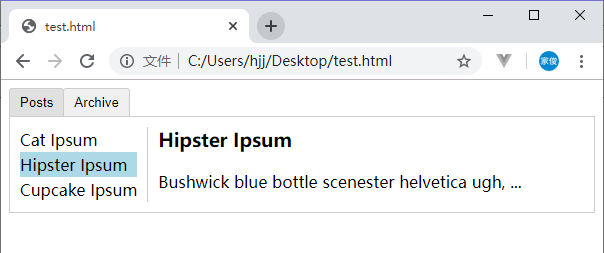1.动态组件
<!DOCTYPE html>
<html>
<head>
<meta charset="utf-8">
<style>
#app {
font-size: 0
}
.dynamic-component-demo-tab-button {
padding: 6px 10px;
border-top-left-radius: 3px;
border-top-right-radius: 3px;
border: 1px solid #ccc;
cursor: pointer;
margin-bottom: -1px;
margin-right: -1px;
background: #f0f0f0;
}
.dynamic-component-demo-tab-button.dynamic-component-demo-active {
background: #e0e0e0;
}
.dynamic-component-demo-tab-button:hover {
background: #e0e0e0;
}
.dynamic-component-demo-posts-tab {
display: flex;
}
.dynamic-component-demo-tab {
font-size: 1rem;
border: 1px solid #ccc;
padding: 10px;
}
.dynamic-component-demo-posts-sidebar {
max-width: 40vw;
margin: 0 !important;
padding: 0 10px 0 0 !important;
list-style-type: none;
border-right: 1px solid #ccc;
line-height: 1.6em;
}
.dynamic-component-demo-posts-sidebar li {
white-space: nowrap;
text-overflow: ellipsis;
overflow: hidden;
cursor: pointer;
}
.dynamic-component-demo-active {
background: lightblue;
}
.dynamic-component-demo-post-container {
padding-left: 10px;
}
.dynamic-component-demo-post > :first-child {
margin-top: 0 !important;
padding-top: 0 !important;
}
</style>
<script src="/UploadFiles/2021-04-02/vue.js">
在动态组件上使用keep-alive,可以在组件切换时保持组件的状态,避免了重复渲染的性能问题。
2.异步组件
Vue 允许你以一个工厂函数的方式定义你的组件,这个工厂函数会异步解析你的组件定义。
Vue.component('async-example', function (resolve, reject) {})
这里可以回顾一下 Vue.js — 组件基础。
我们使用通过webpack打包的Vue项目来介绍异步组件。
<!-- HelloWorld.vue -->
<template>
<div>
<h2 class="title">{{msg}}</h2>
</div>
</template>
<script>
export default {
data () {
return {
msg: 'Hello Vue!'
}
}
}
</script>
<!-- Add "scoped" attribute to limit CSS to this component only -->
<style scoped>
.title {
padding: 5px;
color: white;
background: gray;
}
</style>
<!-- App.vue -->
<template>
<div id="app">
<HelloWorld/>
</div>
</template>
<script>
import HelloWorld from './components/HelloWorld'
export default {
name: 'App',
components: {
HelloWorld
}
}
</script>
<style>
</style>
我们把App.vue的<script>标签里面的内容改为:
export default {
name: 'App',
components: {
HelloWorld: () => import('./components/HelloWorld')
}
}
这样就实现了App组件异步加载HelloWorld组件的功能。
我们可以实现按需加载。
<!-- App.vue -->
<template>
<div id="app">
<button @click="show = true">Load Tooltip</button>
<div v-if="show">
<HelloWorld/>
</div>
</div>
</template>
<script>
export default {
data: () => ({
show: false
}),
components: {
HelloWorld: () => import('./components/HelloWorld')
}
}
</script>
<style>
</style>
这里的异步组件工厂函数也可以返回一个如下格式的对象:
const AsyncComponent = () => ({
// 需要加载的组件 (应该是一个 `Promise` 对象)
component: import('./MyComponent.vue'),
// 异步组件加载时使用的组件
loading: LoadingComponent,
// 加载失败时使用的组件
error: ErrorComponent,
// 展示加载时组件的延时时间。默认值是 200 (毫秒)
delay: 200,
// 如果提供了超时时间且组件加载也超时了,
// 则使用加载失败时使用的组件。默认值是:`Infinity`
timeout: 3000
})
参考:
动态组件 & 异步组件 — Vue.js
以上就是深入了解Vue动态组件和异步组件的详细内容,更多关于Vue动态组件和异步组件的资料请关注其它相关文章!
《魔兽世界》大逃杀!60人新游玩模式《强袭风暴》3月21日上线
暴雪近日发布了《魔兽世界》10.2.6 更新内容,新游玩模式《强袭风暴》即将于3月21 日在亚服上线,届时玩家将前往阿拉希高地展开一场 60 人大逃杀对战。
艾泽拉斯的冒险者已经征服了艾泽拉斯的大地及遥远的彼岸。他们在对抗世界上最致命的敌人时展现出过人的手腕,并且成功阻止终结宇宙等级的威胁。当他们在为即将于《魔兽世界》资料片《地心之战》中来袭的萨拉塔斯势力做战斗准备时,他们还需要在熟悉的阿拉希高地面对一个全新的敌人──那就是彼此。在《巨龙崛起》10.2.6 更新的《强袭风暴》中,玩家将会进入一个全新的海盗主题大逃杀式限时活动,其中包含极高的风险和史诗级的奖励。
《强袭风暴》不是普通的战场,作为一个独立于主游戏之外的活动,玩家可以用大逃杀的风格来体验《魔兽世界》,不分职业、不分装备(除了你在赛局中捡到的),光是技巧和战略的强弱之分就能决定出谁才是能坚持到最后的赢家。本次活动将会开放单人和双人模式,玩家在加入海盗主题的预赛大厅区域前,可以从强袭风暴角色画面新增好友。游玩游戏将可以累计名望轨迹,《巨龙崛起》和《魔兽世界:巫妖王之怒 经典版》的玩家都可以获得奖励。
更新日志
- 小骆驼-《草原狼2(蓝光CD)》[原抓WAV+CUE]
- 群星《欢迎来到我身边 电影原声专辑》[320K/MP3][105.02MB]
- 群星《欢迎来到我身边 电影原声专辑》[FLAC/分轨][480.9MB]
- 雷婷《梦里蓝天HQⅡ》 2023头版限量编号低速原抓[WAV+CUE][463M]
- 群星《2024好听新歌42》AI调整音效【WAV分轨】
- 王思雨-《思念陪着鸿雁飞》WAV
- 王思雨《喜马拉雅HQ》头版限量编号[WAV+CUE]
- 李健《无时无刻》[WAV+CUE][590M]
- 陈奕迅《酝酿》[WAV分轨][502M]
- 卓依婷《化蝶》2CD[WAV+CUE][1.1G]
- 群星《吉他王(黑胶CD)》[WAV+CUE]
- 齐秦《穿乐(穿越)》[WAV+CUE]
- 发烧珍品《数位CD音响测试-动向效果(九)》【WAV+CUE】
- 邝美云《邝美云精装歌集》[DSF][1.6G]
- 吕方《爱一回伤一回》[WAV+CUE][454M]

